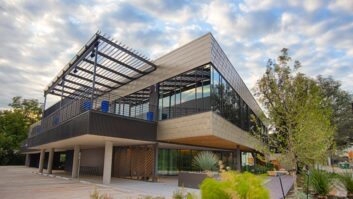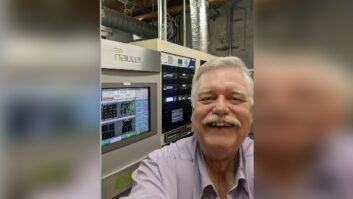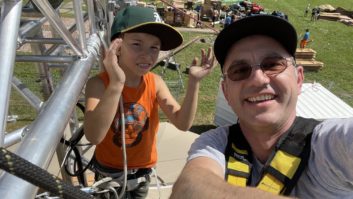Up on a hill just south of downtown Nashville, the “NASH Campus” of Cumulus Media has been demonstrating the future of radio and video integration for more than three years now.
The former home of two local FM stations, WKDF(FM) and WGFX(FM), the building was gutted and extensively rebuilt in 2013 as the new national headquarters for the company’s country music programming.

Control room for “Ty, Kelly and Chuck.”
credit: Scott Fybush
Three studios were purpose-built to house the national “America’s Morning Show” (recently renamed “Ty, Kelly and Chuck”), “NASH Nights Live” and country star Kix Brooks’ “Kickin’ it with Kix” and “American Country Countdown.” Each was built from the start not only to handle the radio broadcast but to be future-proofed for video.
“Every studio is equipped with five stationary video cameras,” says NASH Program Director John Shomby. “Anyone who comes in knows there’s always video being taken. When the mic’s open, the video’s running.”
“PART OF THEIR DNA”
Each of the three studios at NASH was designed to project a specific image on video.
Brooks’ corner studio was built to look like a living room and office, with comfortable sofas and chairs in the center of the room, guitars along the walls ready to be grabbed and played, and a desk and table in the corner adorned with Brooks’ music memorabilia.
Down the hall, the morning show studio puts the hosts and guest on a small stage with audience seating in front of them. And just off the lobby, the “NASH Nights” studio looks most like a traditional radio studio but with plenty of custom lighting and fun visual details such as guitar bodies in place of the usual legs that support the console and desk.
The ORAD camera system at NASH depends on voice activation to direct most of the video switching, automatically choosing video shots based on who’s speaking in front of which mic in each studio.
For Shomby, though, what matters about the visual radio aspect of the NASH campus isn’t the technology but the programming. The veteran programmer says he’s seen a big change in just a few years in how “radio” talent adapt to performing for video. Today, he says, being video-friendly is an essential part of being on the air at a national level.
“I don’t think I have to do anything [to train them],” he says. “Today’s talent is already in that mode. I don’t have to remind them to do video; they just do it. They’re on Facebook Live, they’re on Snapchat, it’s just part of their DNA. Maybe five years ago I would have had an issue with it but not now. The talent that’s at a network level has already been through that change. When we brought Ty Bentli on for the ‘Ty, Kelly and Chuck’ show, (his video skills) were very important.”
Shomby says it’s no longer a question of whether video and other digital content helps the bottom line; it’s simply a part of doing business in today’s media environment for talent and management.
“They know it’s part of the job description now. What goes on the radio is always first priority, after that comes everything else, but it’s all a part of it. It all supports what you’re doing on the air and helps your ratings. In the old days, a personality came in and did the show, maybe they answered request lines, but not much else. Now you’re a multifaceted personality.”
Shomby says this means being comfortable in front of hundreds of thousands of people on a daily basis, which comes more naturally to younger talent.
“You have to be comfortable with it, and those are the ones who succeed,” he said, “but those are also the ones who grew up in front of cameras. The generation that’s coming up now, my 18-year-old is the IT person at home. People are so used to the technology that it’s a part of their life. If we threw them in a studio and took everything away and told them just do a [radio] show, they’d be lost. The older people like me know they’ll be left behind if they don’t learn it.”
That’s changed what Shomby looks for when he’s seeking out new talent.
“You have to think about what someone’s going to look like in front of a camera, how they act, how they communicate socially, all of those things wrapped into one,” he says. “That’s all part of the package. You’re not just doing bits anymore.”
It has also affected another kind of talent: the musicians who make regular treks up the hill to the NASH campus to perform and talk about their work. Shomby says there’s something special about the country format that’s made it easy for those performers to work well with the video aspects of NASH programming.
“They’re very media-savvy,” he says. “It’s part of the process for them to become an artist in Nashville, learning how to be natural, because they make the personalities feel like they’re friends. We’ve had guys over here doing cornhole tournaments.”
Shomby mentions country star Lee Brice, who played college football for Clemson. Before Clemson’s national championship game, Brice stopped by the NASH campus to make a bet with morning co-host Chuck Wicks. With the cameras rolling, Brice picked Clemson to win, while Wicks picked Alabama. If Alabama had won, Wicks challenged Brice to come back to the show wearing an Alabama jersey and sing “Sweet Home Alabama.” (Alas, Clemson won.)
“I can guarantee you right now, Rihanna wouldn’t do that,” Shomby says. “The country artists definitely have a spirit of cooperation, and there’s a spirit of camaraderie between the labels and the artists that doesn’t exist in other formats.”
MORE TO COME
The NASH campus makes it easy for artists to get ready for the video spotlight with some features that weren’t part of traditional radio studio design. There’s not only a green room but a makeup area where visiting performers can make sure they’re camera-ready.
For now, the video that’s generated isn’t seen in real time; instead, digital producers edit shorter bits of content that appear on each show’s social media outlets and can be used by affiliate stations. Shomby says that will change soon, with live streaming in the works.
Later this year, he’s planning to roll out podcasts, which he says will be more than just replays of live show content. “It has to be more than just putting show stuff up on a podcast,” he says. “It’s showing other things that person can do, too.”
Also expect to see some views from above. “I’ve got a drone sitting in my office right now with a GoPro camera sitting on top of it,” Shomby says. “I don’t know yet what we’re going to do with that.”
It’s all part of a future that’s much more than just radio, as Shomby sees it.
“When people walk in here, I try to tell them it’s not a radio station, but what you’re seeing here is really the future of radio,” he says. He arrived at NASH in 2016, after the campus was completed, and praises the facility designers. “They had the vision of what radio is going to be 10 years from now, cameras in every studio, very expensive lighting, that’s where I think it’s headed for everyone.”












